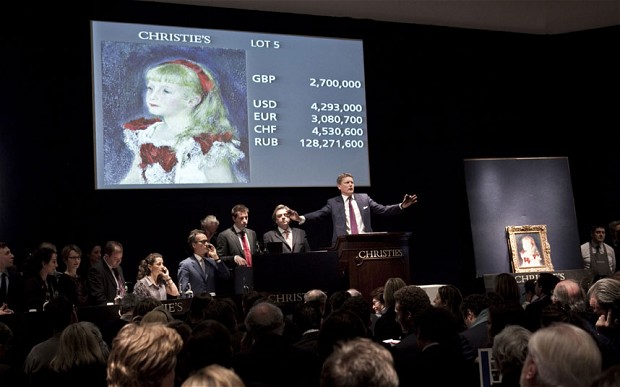Artprice confirms 2013 best year ever in art market
Mar 8th, 2014 | By Ivan Lindsay | Category: Journal
Artprice: The Art Market 2013 +15 % (Art Price Global Index) Best year ever – Art Market Report
Saint-Romain Au Mont, France, March 4, 2014 (GLOBE NEWSWIRE) — As Artprice and thierry Ehrmann, CEO and founder, had sensed, and indeed written, during 2013, year 2013 was indeed the best year ever recorded in auction history (over $12 billion), and the best sale ever for Christie’s in its 247 year-old history – achieved in addition for post-war and contemporary art, with an absolute record for a hammer price: $127 million. This went to a work by the British artist Francis Bacon. 2013 was marked by nearly 15,000 new records for artists, and over 23,000 if first bids are included.
This splendid year was shored up by a globalised demand, particularly with buyers from Asia, the Middle East and Russia, who played a crucial role in the market’s fine performance, and displayed a voracious appetite for flagship artists of the 20th century, landing them in a spate of records.
Artprice.com has been the world leader in art market information since 1987. Each year, it analyses auction results throughout the world, together with variations in the market, quoted values and price indexes for artists and works, and the forces involved in this specific market. It also examines the various cultural sensibilities and the intrinsic relationship between art and money, which produces much covetousness, and a few disappointments as well.
Introduction
In 2010, the several hundred thousand results compiled by Artprice showed that the world of art had been drastically changed by the emergence of a power that no player in the market could hitherto ignore: China, whose annual sales results crushed those of the superpower America for the first time in history. For the fourth year running, China has held out on the US, because the results for 2013 have put it at number one yet again.
In China and the US alike, sales of art works have never been so vigorous. The total of global annual sales was up by 13%, rising from $10.6 billion to $12 billion, and the global price index gained 15 points last year, making for an overall rise of 80% in 10 years.
Are the escalating prices and the prestige sales arousing frenzied competition, where profit can climb by several millions in a few minutes, the symptom of a new speculative bubble? The answer is no, according to the market players, who consider that there has been a profound change in the state of affairs.
Because the art market no longer depends on a handful of wealthy buyers whose withdrawal from the game would cause a general collapse, but is now nourished by a growing number of extremely rich buyers who have been won over to the high spheres of the art market for various reasons. We are now seeing the emergence of new museums designed to make nations shine; private collectors rubber-stamping their pedigrees through the quality of their collections; investment funds which sometimes revise their choices after nurturing micro-bubbles and productive to-ings and fro-ings over new names, and new billionaire buyers for whom the acquisition of a major work is simultaneously a personal adventure, a form of social enhancement and a prime investment.
In addition, eight of the fifty top bids in 2013 went to living artists and the Top 50 bids even include a 21st century work: The Last Supper (2001) by Chinese artist Zeng Fanzhi.
Key figures for 2013
China’s revenues were up yet again in 2013 (+21%) despite an excellent year for the Americans (a rise of around 20%). The twin pole of China and the US controlled nearly 70% of the art market in terms of sales volumes, and the two superpowers were neck and neck. China, number 1 in the global market, posted a total of $4.1 billion; the US also achieved over $4 billion, thanks to a very wealthy globalised demand for names considered as trophies.
Given this steady rise in power, the other market places were left far behind. At $2.1 billion, the UK generated half the revenues of the leaders, but its 3rd place was challenged by no other country, as France, 4th in the ranking, made $549 million (4.5% of the market), followed by Germany ($207 million; 1.7% of the market), Switzerland ($159 million; 1.3% of the market) and Italy ($110 million; 0.9% of the market), the only ones who succeeded in passing the revenue threshold of $100 million.
With an unsold rate of 34% in an overabundant offering, the market had never been so greedy in its history, digesting twice as many works as it did ten years ago. This shows how much broader it has become over the past decade. Sales totalled $12.005 billion, an absolute record in auction history – up by 13% compared with the vintage year of 2012* and by 2.3% compared with the previous record year, 2011, with revenues of $11.78 billion.
*Total sales in 2012 came to $10.6 billion for Fine Art as defined by Artprice.com, i.e. sales of paintings, drawings, sculpture, photography, prints and multimedia for the works of clearly identified artists, the figures of AMMA Artron in the 2012 report being based on a broader spectrum.
Artprice publishes this exclusive report on the art market in six languages. It is quoted by 6,300 international institutions and media each year. Produced using the bidding results from 4,500 auction houses, the 2013 Annual Report consists of macro-economic and micro-economic analyses updated according to new sales and variations in the price of art works. The report, published by Artprice press agency ArtMarketInsight with the econometrics department of Artprice, also contains original rankings such as the Top 500 of artists by turnover, and the list of the 100 highest bids of the year.
thierry Ehrmann
Source: http://www.artprice.com (c)1987-2014 thierry Ehrmann
Download the complete PDF format document:
http://imgpublic.artprice.com/pdf/trends2013_en_fr_de_es_online.pdf

